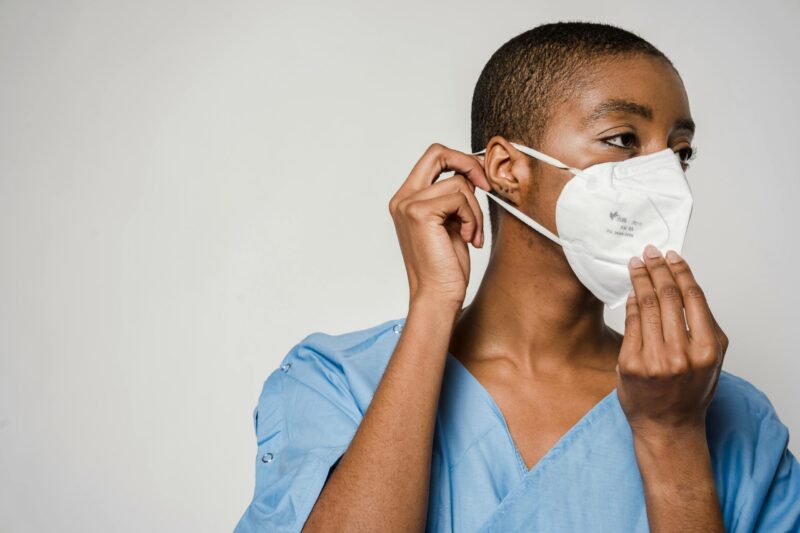Personal Protective Equipment (PPE) plays a pivotal role in safeguarding healthcare professionals and patients from the transmission of infectious agents and ensuring a secure healthcare environment. As health facilities continue to face diverse challenges, having the right types of PPE is critical. This blog will explore eight essential types ofPPEs Your Hospital Must Have to maintain a safe and effective healthcare setting.
1. Masks
Health workers should wear masks to minimize the spread of respiratory diseases and any hazardous infections in a hospital. Masks are also a crucial tool during surgical procedures.
- N95 Respirators: N95 respirators provide a high level of respiratory protection, filtering out airborne particles and offering an effective barrier against respiratory infections such as tuberculosis and COVID-19.
- Surgical Masks: Surgical masks are essential for preventing the spread of respiratory droplets from healthcare professionals to patients and vice versa. They also protect against larger particles and splashes.
- Face Shields: Face shields add an extra layer of protection, covering the entire face and eyes. They are crucial in preventing exposure to respiratory droplets and splashes, especially during procedures with a risk of fluid exposure.
2. Gloves
As simple as they look, gloves are used during several medical procedures and among the PPEs Your Hospital Must Have. They help health workers to reduce risks of contamination, since they handle several items, and even come into contact with body fluids. They help to tame the spread of germs.
- Latex, Nitrile, or Vinyl Gloves: Gloves are a fundamental aspect of infection control, protecting both healthcare professionals and patients from contamination. Latex, nitrile, or vinyl gloves are commonly used based on individual preferences and sensitivities.
- Double Gloving: In high-risk situations or during specific procedures, double gloving provides an additional layer of protection, reducing the risk of contamination.
3. Gowns
Gowns act as a safeguard against fluids. They are crucial for health workers.
- Disposable Isolation Gowns: Isolation gowns are crucial for protecting healthcare professionals from exposure to bodily fluids and other contaminants. Disposable gowns are often preferred for their convenience and hygiene.
- Reusable Gowns: In certain settings, reusable gowns made of durable materials can be an eco-friendly and cost-effective option, provided they are appropriately laundered and maintained.
4. Eye Protection
To guard against hazardous splashes to the eyes, health workers use notable eye protection.
- Safety Goggles: Safety goggles or glasses with side shields protect the eyes from splashes, respiratory droplets, and other potential hazards. They are essential in procedures where there is a risk of exposure to bodily fluids.
5. Head Covers
Medics wear head covers to protect themselves from contamination arising from fluid splashes or airborne exposure.
- Bouffant Caps or Surgical Hoods: Head covers, such as bouffant caps or surgical hoods, prevent hair and scalp exposure, maintaining a sterile environment during surgical procedures or in areas with infection control requirements.
6. Shoe Covers
Shoe covers offer crucial protection from contamination. Doctors wear the shoe covers when entering a ward or attending to patients with compromised immune systems in a health setting. They prevent germs from being carried from room to room or different locations.
- Disposable Shoe Covers: Disposable shoe covers are vital for preventing the spread of contaminants from footwear. They are particularly useful in operating rooms, cleanrooms, or areas with strict hygiene protocols.
7. Respirators
Respirators offer secure protection against airborne particles. They include the Powered Air-Purifying Respirators (PAPRs). PAPRs offer a higher level of respiratory protection in situations where airborne particles are a significant concern. They consist of a powered unit that filters and delivers clean air to a hood or helmet worn by the healthcare professional.
8. Hand Hygiene Products
Medical workers handle many things during service delivery, and risk transferring germs to sterilized or clean surfaces. Hand hygiene products help to protect medics and patients alike by promoting hand hygiene. Health facilities should provide hand sanitizers with at least 60% alcohol and promote regular hand washing with soap and water.
Conclusion
Ensuring the availability and proper use of a comprehensive array of PPE is paramount for the safety and well-being of healthcare professionals, patients, and the broader community. Each type of PPE serves a specific purpose in mitigating the risks associated with infectious diseases and other hazards. Health facilities must prioritize the procurement, proper utilization, and ongoing training related to PPE to maintain a secure and resilient healthcare environment. By investing in the right types of PPE, health facilities demonstrate a commitment to infection control, employee safety, and the overall health of their communities.


Write a comment
Your email address will not be published. All fields are required